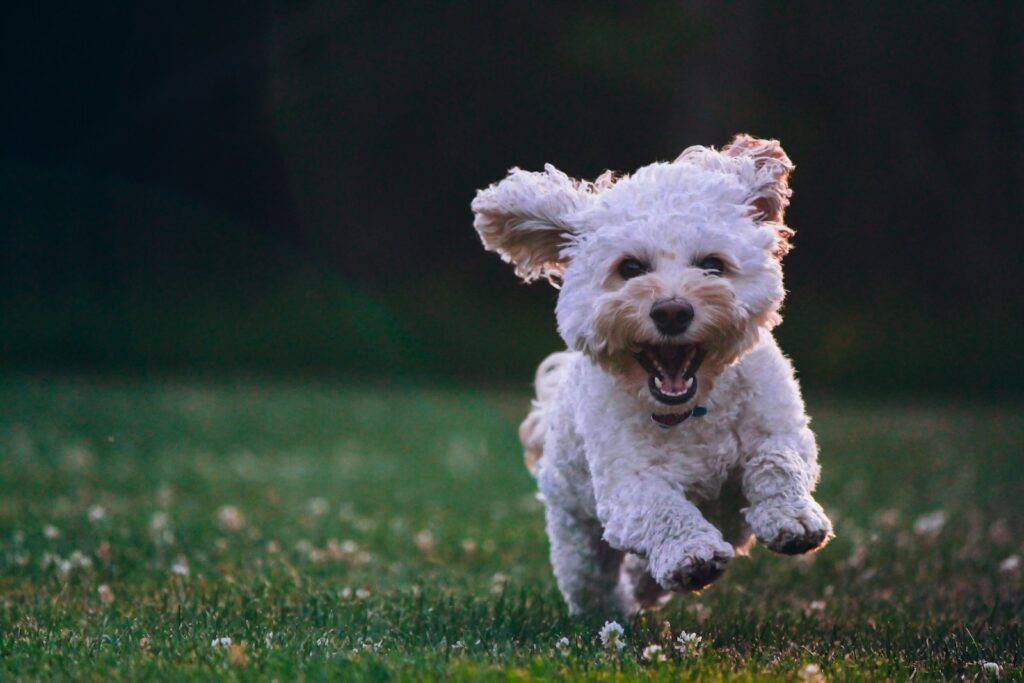If you’re a proud Cockapoo parent like me, you’ve probably found yourself puzzled at times by your furry friend’s behavior. What’s Fido trying to tell you with that wagging tail, those pricked ears, or that intense stare? Understanding your Cockapoo’s body language and communication can feel like learning a whole new language, but don’t worry—I’m here to help!
Cockapoos are a bundle of joy with their own unique way of expressing themselves. They’re known for their intelligence and expressive nature, making them one of the most communicative breeds out there. But if you’re not familiar with their language, you might miss out on what they’re trying to tell you.
Why is it important to understand Cockapoo body language and communication?
Understanding your Cockapoo’s body language and communication is not just about forming a strong bond – it’s also about ensuring their health and happiness. Recognizing change in body language or behavior can often be the first indication of a potential health problem. Since Cockapoos are unable to tell us verbally when they’re unwell, we must rely on their body language to keep them safe and healthy.

An essential aspect is understanding their playful behavior. Cockapoos are known for being friendly and full of energy. They communicate their willingness to play through a set of behaviors including a wagging tail, leaping, and boundless energy. Ignoring these signals could lead to frustration and a sense of isolation for your pooch.
On the flip side, if you see your Cockapoo exhibiting unusual behavior – perhaps they seem withdrawn or they’re not showing their usual enthusiasm for play – it could indicate distress or illness. The ability to discern changes in behavior thus becomes crucial for early detection and treatment of potential health issues.
However, it’s not only about health. Understanding your Cockapoo’s communication helps in fostering a strong bond. Every interaction you have with your pup strengthens your bond with them – knowing what they’re trying to tell you through their body language can ensure each interaction is a positive one. It’s about communicating effectively, respecting their signals, and providing them the care and attention they need.
So, it’s quite apparent why understanding your four-legged friend’s body language and communication is crucial. From ensuring their well-being to promoting a strong bond, getting a sense of their communication styles can be a game-changer.
Analyzing tail wagging of Cockapoos
Let’s dwell deeper and understand another important body language of Cockapoos: tail wagging.
Tail wagging has a language of its own. It is not just a mere sign of happiness as popularly believed. It can signal various emotions – from joy to fear, from excitement to nervousness.
Understanding the specifics of tail wagging can give you a better insight into what your Cockapoo might be trying to tell you. Let’s unpack the nuances.
When your Cockapoo wags its tail vigorously, it’s often a sign of excitement or happiness. You’ll usually see this behavior when you return home after a long day. It’s their way of saying, “Yay! My favorite person is back!”
On the other hand, a slow and deliberate wag may indicate a cautious approach. If a stranger approaches, your Cockapoo might not wag their tail a lot, signaling that they’re unsure about the newcomer. It’s a clear indication that your pet is unsure and sizing up the situation.
A tail held high with a rapid wag is a sign of alertness and confidence. It’s a clear indicator that your pet is ready for action. Conversely, a lowered tail, especially if tucked between their legs, is a sign of fear or submissiveness.
Here’s an interesting fact: the direction of wagging matters as well. Studies suggest that dogs wagging their tails to their right side are feeling positive emotions, while wagging to the left might indicate negative emotions.
So, keep an eye on that wagging tail! By recognizing the subtle differences, you will understand your Cockapoo’s feelings better. This knowledge will help you create more supportive, positive environments for your furry friend, fostering an even stronger bond between you two.
The meaning behind Cockapoo ear positions
In our journey of understanding Cockapoo body language, we can’t overlook the role of their ears. The ears of a Cockapoo are just as expressive as their tails and play a crucial role in expressing their emotions.
Have you ever noticed your Cockapoo focusing all its attention on something with perky, straight ears? That’s their alert and attentive state. They’re taking in all the sounds from their environment, and their ears handy tools for this task.
In contrast, when a Cockapoo feels scared or uncomfortable, their ears are in a completely different position. They’ll fold their ears back against their head. This is a universal canine sign of being uneasy or scared. Observe this behavior and the surrounding circumstances. Identifying the triggers causing your furry friend discomfort is vital for their well-being.
Let’s talk about a relaxed Cockapoo, shall we? During their chill time, their ears are usually in a neutral position – not pricked up or folded back, but comfortably resting. This indicates that your pup is feeling pretty good about life and is not expecting anything unusual.
What about when your Cockapoo is feeling playful and excited? Their ears might twitch or wiggle! Every Cockapoo is unique in how they express excitement but watch for ear movement during playtime, and you’ll begin to see patterns.
Remember, every Cockapoo is unique, and so is their ear language. Your observation and time spent with them will help you decipher their unique signs. You’ll probably notice those not mentioned here since you’re their favorite human, after all!
As we navigate our pets’ body language, it’s fascinating to see how much they try to communicate with us. Fully understanding their cues, including ear positions, will only deepen our relationship with them. Speaking of relationships, the next section will divulge exactly how critical respect is in your bond with your Cockapoo. So let’s keep exploring, shall we? Up next is “Understanding and Respecting Your Cockapoo’s Boundaries”.
Decoding Cockapoo eye contact and facial expressions
Eye contact plays a huge role in canine communication. For Cockapoos, those little eyes are windows to their soul and might tell you a lot about what’s going on inside their fluffy heads. A steady eye indicates focus while an averted gaze could mean they’re feeling threatened or shy.
Ever notice your Cockapoo giving you the “puppy dog eyes”? It’s their way of saying they want something. On the other hand, dilated pupils hint at fear or excitement, requiring immediate attention. During play or training sessions, I’ve found my Cockapoo’s eyes to be a reliable source of feedback about how comfortable, curious, or excited they might be feeling.
Facial expressions, while diverse and complex, are equally telling. Raised brows suggest curiosity or surprise. If they’re furrowing their brows and have a wrinkled forehead, it might mean they’re trying to figure something out or they’re feeling uneasy.
A relaxed open mouth with a lolling tongue is usually a sign of contentment and excitement in Cockapoos. Their big, loving smiles are sometimes accompanied by gentle panting.
Let’s not forget about the tell-tale signs delivered by a silent yawn. Those innocent yawns may appear as signs of boredom, but sometimes they’re nestled within hints of stress or anxiousness. More than once, I’ve observed my Cockapoo yawning unnecessarily during a stressful situation.
Even something as simple as a sneeze can signify playfulness rather than a common cold. My Cockapoo loves to sneeze when it’s in mid-play, a behavior I’ve come to recognize as a sign of their enjoyment and request for continued fun.
The aim here is not to create a scientific manual, but an everyday guide to what your Cockapoo is likely trying to communicate. As we already established, every Cockapoo is different. With time and patience, you’ll learn to interpret your own Cockapoo’s unique communication style. It’s about forming a bond and understanding their distinctive world.
The different vocalizations of Cockapoos and what they mean
After we’ve drilled into the significance of a Cockapoo’s body language, let’s get our ears to work. Understanding Cockapoo vocalizations can be a tremendous help in deciphering their needs, emotions, and even their health state.
One of the first sounds you’ll note from a Cockapoo is their bark. A Cockapoo’s bark can vary in pitch, duration, and frequency, each telling a unique story. A high-pitched bark often indicates excitement or the need for attention. In contrast, a low, drawn-out bark could suggest your furry friend feels threatened or scared.
Next, we have growling. Growling from a Cockapoo is just as essential to comprehend. It’s not always a bad sign! For instance, a low, quiet growl usually means that they’re enjoying playtime. However, if the growl increases in volume and intensity, it could signal that your Cockapoo is feeling agitated or threatened.
Howling is another way Cockapoos express themselves. It’s usually a sign that your Cockapoo is discontent or lonely. This can often happen if they’re left home alone for too long.
Lastly, Cockapoos might ‘talk’ using a series of whines and whimpers, especially when they’re in distress or craving more attention.
Understanding these vocalizations is just as important as understanding their facial expressions or tail wags. And remember, no two Cockapoos are the same. Some might be more vocal than others, but each has their unique ‘vocabulary’. So, listening and learning will bring you one step closer to your Cockapoo. It’s all part of the journey as you continue building that strong, unbreakable bond.
Conclusion
So there you have it. Decoding your Cockapoo’s body language and vocalizations isn’t just about training or obedience – it’s about building a stronger bond and ensuring their happiness. Remember, every tail wag, ear twitch, bark, or whine is a window into their feelings. It’s our job to understand and respond appropriately. By doing so, we can form a deeper connection with our furry friends and ensure we’re meeting their needs. After all, isn’t that what being a pet parent is all about? So let’s keep those ears perked and eyes peeled for what our Cockapoos are trying to tell us. Here’s to happier and healthier communication with our beloved Cockapoos!
Lise Horvath is a dedicated canine enthusiast and the passionate author behind CockapooMom.com, a trusted resource for Cockapoo owners seeking reliable information on caring for their beloved furry companions. With years of hands-on experience in canine behavior and nutrition, Lise brings a wealth of expertise to her writing, ensuring that CockapooMom.com offers authoritative guidance on topics ranging from training and health to lifestyle and nutrition.
Driven by her genuine love for Cockapoos and a commitment to promoting their well-being, Lise meticulously researches and curates content that reflects the latest industry standards and best practices. Her comprehensive articles are backed by reputable sources and tailored to address the unique needs of Cockapoo dogs, earning CockapooMom.com a reputation as a go-to resource for discerning pet parents.
Lise's dedication to transparency and accuracy is evident in her meticulous approach to content creation, prioritizing the dissemination of trustworthy information that empowers Cockapoo owners to make informed decisions about their pets' care. Through CockapooMom.com, Lise aims to foster a supportive community of dog lovers while upholding the highest standards of expertise, authoritativeness, and trustworthiness in the realm of canine care.
Connect with Lise and join the CockapooMom.com community to embark on a fulfilling journey of companionship and care with your Cockapoo companion.


